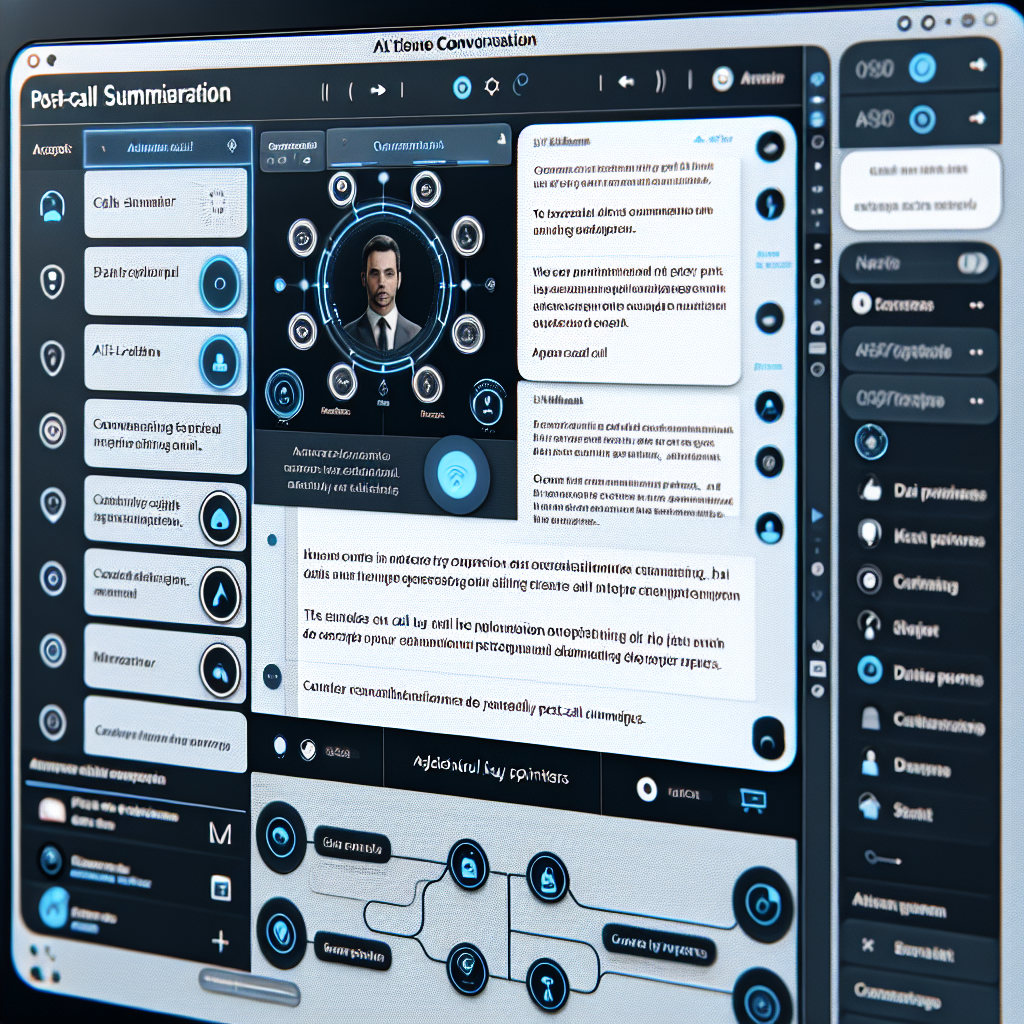
In our rapidly digitalizing world, the role of artificial intelligence (AI) cannot be overstated. One area where this is notably evident is in business communication, particularly in relation to phone conversations. Modern technology, courtesy of AI, has the power to automate the previously laborious task of transcribing and summarizing call contents for future reference or action. AI tools are being increasingly deployed for automating call summaries and post-call documentation, effectively rewriting the rules of engagement in customer interaction and business communication.

Post-call documentation has conventionally been a time-consuming process, dependent largely on the employee’s ability to accurately remember, note, and interpret important points from customer calls. This manual approach often leaves room for errors and inconsistencies. However, AI-driven tools now offer a high degree of automation in call documentation, enabling businesses to capture, record, and transcribe call contents with remarkable precision.
These AI tools go beyond simple transcription; they use advanced algorithms to understand context, extract key points, and generate concise summaries that can be quickly reviewed and acted upon. This takes the strain off employees, who can focus their energies on more valuable tasks rather than getting caught up in the wearisome cycle of manual documentation. Moreover, with automated call summaries, businesses can ensure consistency and objectivity in their call documentation, thereby improving the quality and reliability of their customer interaction records.
In summary, AI in call documentation is ushering in a new era of efficiency in business communication, with transformative effects on employee productivity and customer relationship management. With the ability to automate the entire process of call summarizing, AI is providing businesses with a powerful tool to streamline their operations and enhance their customer service.
As we continue to leverage the capabilities of AI in various facets of organizational operations, it's clear that this technology has a lot more to offer in the days ahead, particularly in the realm of business communication.
As businesses continue to leverage technological advancements to optimize their operations, artificial intelligence (AI) plays a crucial role in transforming customer service workflows. One such intriguing application of AI is in the automation of call summaries.
An AI-driven system capable of generating call summaries operates primarily through the synergy of Natural Language Processing (NLP) and machine learning. To understand the process, let us delve into its three fundamental stages: listening, transcribing, and summarizing.
The listening stage involves AI systems closely monitoring phone conversations in real time. Enhanced by machine learning algorithms, these systems recognize and understand spoken language. This technology, often referred to as speech recognition, allows the AI to distinguish different voices, accents, and even various languages.
Following this, the transcribing stage takes place. Here, the AI converts the captured audio data into textual format using NLP. It comprehends the contextual importance by identifying keywords and extracting essential topics from the conversation. The process entails syntactic analysis and semantic interpretation, which further refines the transcription process.
Lastly, the summarizing phase finally transforms the transcribed text into a precise and easily readable call summary. This stage uses advanced NLP techniques such as abstractive and extractive summarization. AI can identify key takeaways and express them coherently, producing a detailed report capturing the essence of the call.
By automating call summaries with AI tools, businesses can improve efficiency, enhance customer interactions, and boost their decision-making capabilities. This shows promising prospects for the future of AI in customer service.
As technology continues to advance, AI-powered documentation tools have become an essential component in the world of customer service and sales call centers. They are smart tools used to automatically document the details of a call, removing the need for representatives to manually record the information. These tools have a wide array of impressive features, which we will explore in this section.

One of the key features of these AI tools is real-time transcription. Making use of sophisticated speech recognition technology, these tools listen to the call, accurately transcribe the conversation, and present it in a clear, easily accessible format. This not only saves considerable time but also increases the accuracy and precision of data recording.
Another remarkable feature is sentiment analysis. These smart tools analyze the tone and mood of the conversation, helping supervisors understand customer sentiments. The result is a service that can be tailored to meet the exact needs of each customer. More so, it can provide vital insights into the overall customer satisfaction and areas where improvement is needed.
Last but not least, AI documentation tools are enhanced with integration capabilities. They can easily integrate with a range of other office applications – CRM, email, calendar, and more. This seamless integration allows the sharing of notes and summaries between teams, boosting collaboration and consistency within the company.
In summary, AI documentation tools are valuable assets for call centers, offering real-time transcription, sentiment analysis, and integration capabilities amongst a host of other features. By automating tedious post-call documentation tasks, these AI-powered tools leave representatives free to enhance the customer experience, thereby improving overall business productivity.
In the fast-paced world of business, automating call summaries with the use of AI technologies has become a significant game-changer. The application of AI for post-call documentation brings a host of benefits, not least of which include enhanced accuracy and accelerated processing times.
For a start, the introduction of AI in generating call summaries can greatly increase accuracy. AI systems are immune to human exhaustion and can meticulously analyse even the most complex data, weeding out any potential inaccuracies. As such, they can generate highly precise summaries, significantly reducing the chances of AI-oriented mistakes.
Faster processing times is another noteworthy advantage. To manually draft a call summary can be a long and arduous task, especially in the face of voluminous call data. However, AI-driven software demonstrated its capacity to process vast amounts of information in mere seconds, rendering traditional methods obsolete. Consequently, businesses can now curate insightful summaries in record time, freeing their personnel for other vital tasks.
Moreover, there is an added benefit of flexibility and scalability. These AI tools for post-call documentation can operate ceaselessly, expanding a company's capabilities beyond regular working hours and easily scaling up with the growing call volume. This means businesses can now ensure comprehensive coverage of their customer interactions at all times.
User-friendliness is a crucial factor for any new technology to seamlessly integrate into an existing workflow. Thankfully, modern AI-powered software is designed with an easy-to-navigate interface and minimal learning curve. This user-friendly nature of AI tools allows businesses to adopt and adapt to this technology more smoothly.
Ultimately, adopting AI tools for automating call summaries provides enormous benefits to businesses. Not only does it help improve accuracy and efficiency, but it also improves scalability and allows for seamless integration into existing workflows. In a world where every second counts, automating call summaries is a step towards the future that no business should miss.
Automating Call Summaries and integrating AI tools into the customer service process has reaped substantial benefits for numerous businesses across diverse industries. It has amplified productivity, enhanced customer experience, and augmented analytic capabilities. To validate this, let's delve into a couple of real-world success stories.

Firstly, the Amdocs story. Amdocs is a leading software & services provider to communications and media companies. The company successfully leveraged AI to automate their post-call summaries and the results were exceptional. By implementing an AI tool that accurately transcribes and summaries call, they were able to reduce the manual effort involved in call documentation, increasing operational efficiency by leaps and bounds. Moreover, the use of AI made sure that the summaries were accurate, reliable, and far more detailed than humanly possible.
Secondly, there's HubSpot, a development platform that provides software products for inbound marketing, sales, and customer service. They integrated an AI tool into their customer service system to automate call documentation. The result was a more effective workflow where employees could focus on resolving issues rather than spending time on paperwork. By recording and transcribing calls, the AI tool not only enhanced productivity but also improved the quality of service that resulted in increased customer satisfaction rates as well as positive customer feedback.
In both cases, Automating Call Summaries proved instrumental in enabling the companies to streamline their processes, focus more on the core aspects of customer service, and deliver better results.
As these case studies illustrate, integrating AI into customer service processes, particularly for automating call summaries, allows businesses to elevate their capacity, efficiency, and effectiveness. With AI by their side, businesses are not just evolving, but revolutionizing the way they handle customer service.
The advent of Artificial Intelligence (AI) has brought significant changes in many industries, and customer service is no exception. One of the key areas where AI is making a considerable impact is in automating call summaries and post-call documentation. This is a shift being driven not only by advancements in AI technology, but also the growing need for efficient customer service operations.
As we look to the future, the pervasion of AI technology in the realm of call documentation seems poised to increase. Advances in Natural Language Processing (NLP) and Machine Learning (ML) are driving the development of AI tools that can analyze call data in real-time, improving the accuracy and consistency of post-call documentation.
One anticipated trend is the enhanced integration of voice recognition within AI tools. Voice recognition not only automates transcription but also enables the software to identify customer sentiment and key issues discussed during the call. This gives customer service reps invaluable insights and helps them respond more effectively to customer needs.
We also expect to see growing adoption of context-aware AI technologies in call documentation. This means AI tools will get better at understanding the specific context of customer interactions, thereby drafting more accurate call summaries. It's not a far-fetched expectation considering the rapid progression of AI capabilities.
The implication of these AI trends for businesses cannot be overstressed. By automating post-call documentation, organizations can significantly reduce administrative burdens on customer service reps, allowing them to focus more on resolving customer issues. This ultimately leads to improved customer service delivery and a better customer experience.
In conclusion, AI tools for post-call documentation are likely to become even more sophisticated and indispensable in the future. As the technology evolves, it may eventually become possible for AI to almost entirely take over the task of post-call documentation, while customer service reps focus entirely on customer engagement and problem-solving.
Start your free trial for My AI Front Desk today, it takes minutes to setup!








